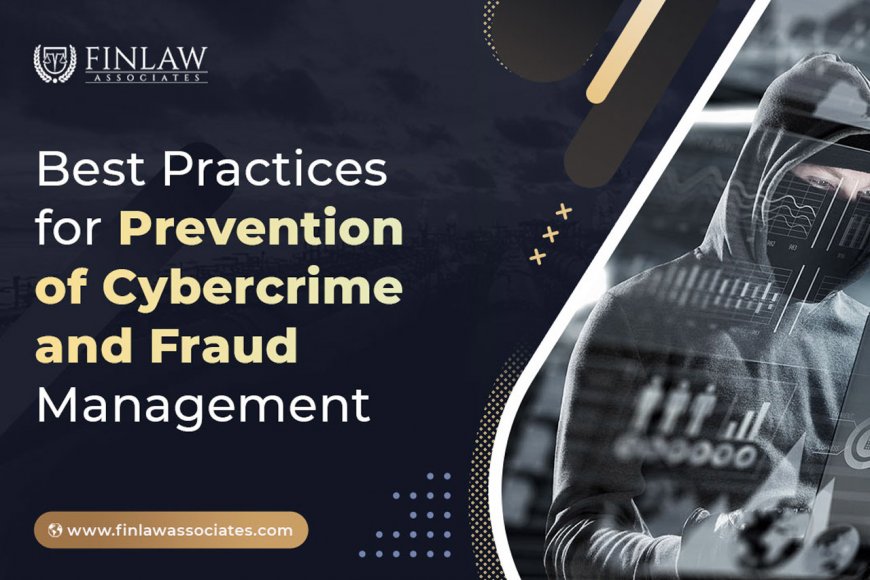Best Practices for Prevention of Cybercrime and Fraud Management
Discover the best practices for the prevention of cybercrime and fraud management to protect your business from online threats and financial fraud.

In today's rapidly evolving digital landscape, India has witnessed a significant surge in cybercrime and fraud incidents. According to recent reports, the fiscal year 2024 alone saw cyber fraud cases escalate over fourfold, resulting in financial losses of nearly $20 million. This alarming trend underscores the imperative for robust strategies in cybercrime prevention and fraud management.
As digital platforms become central to business operations and personal activities, ensuring the security of information has become a critical necessity. This article explores the best practices for preventing cybercrime and effectively managing fraud in various sectors.
What Is Cybercrime and Fraud Management?
Understanding Cybercrime
Cybercrime refers to any illegal activity conducted using computers, digital devices, or networks. These crimes target individuals, businesses, and government institutions with the intent to cause financial or reputational harm. Some of the most common types of cybercrime include:
-
Phishing Attacks: Fraudulent attempts to obtain sensitive information by disguising as trustworthy entities.
-
Ransomware Attacks: Malicious software designed to block access to a computer system until a sum of money is paid.
-
Identity Theft: Unauthorized use of someone’s personal information to commit fraud.
-
Data Breaches: Unauthorized access to sensitive data of companies or individuals.
Understanding Fraud Management
Fraud management involves identifying, preventing, and mitigating fraudulent activities within an organization. It includes implementing security measures, monitoring suspicious activities, and creating a rapid response mechanism to address any breaches or attacks.
Best Practices for Prevention of Cybercrime and Fraud Management
To protect organizations and individuals from growing cyber threats, it is crucial to follow certain best practices for cybercrime prevention and fraud management.
1. Implement Comprehensive Security Policies
Every organization should have clear and comprehensive cybersecurity policies. This includes:
-
Acceptable Use Policies (AUP)
-
Data Protection and Privacy Policies
-
Incident Response Policies
Employees must understand their responsibilities in protecting company assets and information. Regular training and updates about new cybersecurity threats can help in reducing internal security breaches.
2. Conduct Regular Risk Assessments
Organizations should conduct periodic risk assessments to identify potential vulnerabilities in their network infrastructure. Some effective risk assessment methods include:
-
Penetration Testing
-
Vulnerability Scanning
-
Network Audits
By proactively addressing vulnerabilities, organizations can prevent data breaches and financial losses.
3. Enhance Employee Training and Awareness
A significant number of cybercrimes occur due to human error. Regular training sessions on cybersecurity can equip employees with the knowledge to:
-
Identify phishing emails
-
Avoid clicking on suspicious links
-
Recognize social engineering attacks
-
Report suspicious activities
Building a security-aware workforce significantly reduces the risk of cybercrimes.
4. Implement Multi-Factor Authentication (MFA)
Multi-factor authentication (MFA) adds an additional layer of security by requiring users to provide two or more verification factors to access their accounts. This makes it difficult for cybercriminals to gain unauthorized access, even if they obtain the user's password.
Some popular MFA methods include:
-
One-time Passwords (OTP)
-
Biometric Verification
-
Security Questions
5. Encrypt Sensitive Data
Data encryption converts sensitive information into unreadable code, ensuring that unauthorized users cannot access or misuse it. Organizations should:
-
Encrypt data during transmission (TLS/SSL)
-
Encrypt data at rest (AES-256)
-
Use end-to-end encryption for communications
Encryption is essential for protecting personal and financial information from cybercriminals.
6. Maintain Updated Systems and Software
Outdated software often contains vulnerabilities that cybercriminals exploit. Organizations must regularly update their:
-
Operating systems
-
Antivirus software
-
Web browsers
-
Firewalls
Applying security patches and software updates can significantly reduce the chances of cyberattacks.
7. Develop a Robust Incident Response Plan
Having a well-documented incident response plan allows organizations to act swiftly in the event of a security breach. Key elements of an incident response plan include:
-
Identification of Threats
-
Containment and Eradication
-
Recovery and Restoration
-
Post-Incident Analysis
The goal is to minimize the impact of a breach and resume operations as quickly as possible.
8. Engage in Continuous Monitoring
Continuous monitoring of network traffic and user behavior helps in early detection of suspicious activities. Security Information and Event Management (SIEM) tools can automate this process by:
-
Detecting anomalies
-
Logging security events
-
Generating real-time alerts
Proactive monitoring can prevent data breaches and unauthorized access attempts.
9. Collaborate with Cybersecurity Experts
Partnering with external cybersecurity firms provides organizations with advanced threat intelligence and defense mechanisms. These experts can help in:
-
Conducting vulnerability assessments
-
Implementing security controls
-
Responding to security breaches
Collaboration strengthens overall security posture.
10. Ensure Compliance with Regulatory Standards
In India, organizations must comply with Cybercrime legal frameworks such as:
-
The Information Technology Act, 2000
-
Personal Data Protection Bill, 2019
-
Reserve Bank of India (RBI) Guidelines
Complying with these regulations minimizes legal risks and enhances security measures.
Government Initiatives for Cybercrime Prevention in India
The Government of India has launched several initiatives to combat cybercrime and promote fraud management. These include:
1. Indian Cyber Crime Coordination Centre (I4C)
The I4C is a central agency that investigates and coordinates major cybercrime cases across the country. It operates under the Ministry of Home Affairs.
2. Cyber Swachhta Kendra
This is a botnet cleaning and malware analysis center initiated by CERT-In (Computer Emergency Response Team-India). It helps individuals and organizations clean their infected systems.
3. National Cyber Security Policy 2013
This policy provides a framework to ensure the security of cyberspace and critical infrastructure.
4. DigiKavach Initiative
DigiKavach is a fraud detection and prevention program initiated by Google in India. It helps identify online financial frauds and protect users from cyber threats.
Conclusion
Preventing cybercrime and effectively managing fraud requires a collaborative approach between organizations, individuals, and government agencies. Implementing strong security policies, continuous monitoring, employee training, and strict regulatory compliance can significantly reduce the risks of cybercrime. With the growing digital landscape in India, prioritizing cybersecurity has become more critical than ever.
By following these best practices for prevention of cybercrime and fraud management, organizations can safeguard their digital infrastructure and build trust with customers. Staying informed and proactive is the key to minimizing cyber threats in the ever-evolving digital world.
What's Your Reaction?















